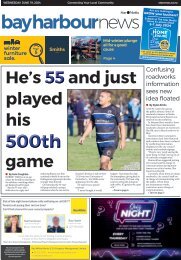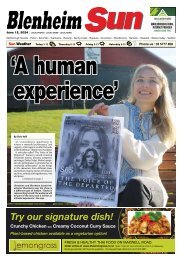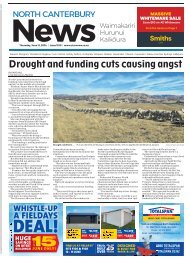The Star: October 08, 2020
You also want an ePaper? Increase the reach of your titles
YUMPU automatically turns print PDFs into web optimized ePapers that Google loves.
Thursday <strong>October</strong> 8 <strong>2020</strong> <strong>The</strong> <strong>Star</strong><br />
WATER QUALITY in most<br />
Christchurch waterways has<br />
remained steady but the majority<br />
are still ranked as ‘poor’, a new<br />
city council report shows.<br />
<strong>The</strong> council has published its<br />
annual Christchurch Surface<br />
Water Quality Report, an analysis<br />
of water quality data collected<br />
throughout last year.<br />
Council waterways ecologist<br />
Dr Belinda Margetts led the<br />
research, and says water quality<br />
in most Christchurch waterways<br />
is unchanged from previous<br />
years.<br />
“<strong>The</strong>re were some improvements<br />
and some declines in water<br />
quality at certain sites, but overall<br />
the quality is much the same<br />
as we’ve seen previously,” said<br />
Margetts.<br />
But improving water quality<br />
is a slow process, she said, as<br />
Christchurch’s waterways suffer<br />
from a condition known as ‘urban<br />
stream syndrome’.<br />
“<strong>The</strong> main contaminants in our<br />
waterways are from waterfowl<br />
droppings, dog poo and stormwater<br />
run-off contaminated with<br />
metals from cars and roofs, and<br />
sediment.<br />
“<strong>The</strong> contaminants of most<br />
concern include nitrogen, phosphorus,<br />
Escherichia coli (an indicator<br />
of faecal contamination that<br />
can cause illness), and dissolved<br />
zinc and copper.”<br />
Waterways are monitored at<br />
42 sites across the district, with<br />
more than 11,000 tests being<br />
conducted.<br />
Of the samples tested, 20 per<br />
cent did not meet quality guideline<br />
levels and 98 percent of sites<br />
did not meet guideline levels for<br />
at least one of the quality factors<br />
measured.<br />
After all the data had been analysed,<br />
each monitoring site was<br />
scored, with most being ‘poor’.<br />
None were ‘very good’ and none<br />
were ‘very poor’.<br />
“<strong>The</strong> catchment with the best<br />
overall water quality was the<br />
Ōtūkaikino River catchment<br />
and the worst was the Ōpawaho-<br />
Heathcote River catchment,” said<br />
Latest Canterbury news at starnews.co.nz<br />
Waterways still rated ‘poor’ – report<br />
QUALITY: <strong>The</strong> Ōtūkaikino River, which runs through <strong>The</strong><br />
Groynes.<br />
PHOTO: NEWSLINE<br />
Margetts.<br />
Of all the sites monitored, the<br />
site with the best score was in<br />
the Pūharakekenui-Styx River at<br />
Main North Rd.<br />
<strong>The</strong> site with the worst score<br />
was in Curletts Rd Stream, with<br />
the next lowest being in the<br />
Ōpawaho-Heathcote River at<br />
Tunnel Rd, Haytons Stream and<br />
the Ōpawaho-Heathcote River at<br />
Ferrymead Bridge.<br />
Margetts says the priority areas<br />
for improving water quality are<br />
the Haytons and Curletts Rd<br />
streams and middle tributaries of<br />
the Ōtākaro-Avon River catchment<br />
– Riccarton Main Drain,<br />
Addington Brook and Dudley<br />
Creek.<br />
<strong>The</strong> council also produces<br />
annual waterway report cards,<br />
which combine these water quality<br />
results with other ecological<br />
data.<br />
<strong>The</strong> overall score for the<br />
Ōtūkaikino River catchment was<br />
B (good) and the Pūharakekenui-<br />
Styx River catchment was C (fair).<br />
<strong>The</strong> Ōtākaro-Avon River, Huritini-Halswell<br />
River and Ōpawaho-<br />
Heathcote River catchments all<br />
scored D (poor).<br />
In spite of there being room for<br />
improvement, Margetts says the<br />
city’s waterways, especially the<br />
more rural waterways of Banks<br />
Peninsula, are home to many<br />
threatened species.<br />
Some of these species were<br />
gathered by Māori as mahinga<br />
kai (food), including wai kōura<br />
(freshwater crayfish), kākahi<br />
(freshwater mussels), tuna (longfin<br />
eel) and inanga (a whitebait<br />
species).<br />
“Christchurch waterways<br />
contain many spawning sites<br />
for inanga, pockets of kākahi in<br />
large numbers, and one of the few<br />
known spawning sites for kanakana<br />
(lamprey),” says Margetts.<br />
“<strong>The</strong> important thing is to<br />
make sure our waterways don’t<br />
decline further and that everything<br />
possible is done to protect<br />
and improve them so that these<br />
and other species can continue to<br />
thrive.”<br />
NEWS 19<br />
Wastewater<br />
discharge views<br />
to be discussed<br />
OPTIONS ON how Akaroa’s<br />
wastewater should be discharged<br />
are being mulled over next week.<br />
<strong>The</strong> Akaroa Treated Wastewater<br />
Options Hearings Panel will<br />
start hearing oral submissions<br />
on Monday.<br />
<strong>The</strong> city council sought submissions<br />
on the project over four<br />
weeks in July and August.<br />
Four options for dealing with<br />
highly treated wastewater from<br />
Akaroa were presented for feedback<br />
– three where the treated<br />
wastewater would be used to<br />
irrigate new areas of native<br />
trees and one where it would be<br />
piped out into the mid-harbour<br />
through a new outfall.<br />
At the close of consultation<br />
341 submissions had been received<br />
from individuals, organisations<br />
and businesses, with 83<br />
asking to speak at the hearings.<br />
Submitters were asked five<br />
questions.<br />
<strong>The</strong> two most pertinent<br />
were whether they favoured<br />
highly treated wastewater being<br />
discharged to land or to the<br />
harbour, and then, if the mayor<br />
and councillors decide it should<br />
go to land, which of three<br />
locations would the submitter<br />
prefer – Inner Bays (Robinsons<br />
Bay, Takamātua and Hammond<br />
Point), Goughs Bay, or Pompeys<br />
Pillar.


















